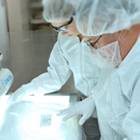BIOSENSIS PTY
Artikel-Nr:
(BSENM-1385-100)
Lieferant:
Biosensis
Hersteller-Artikelnummer::
M-1385-100
Lokale Artikelnummer::
BSENM-1385-100
Beschreibung:
Nestin is a member of the class IV intermediate filament protein family which is expressed in neuronal stem cells. The molecular weight of human Nestin as determined by SDS-PAGE mobility is about 240kDa. However the real molecular weight is considerably less than this, at 177kDa, the disparity being likely due to the highly charged region of the C-terminal segment. Nestin is relatively poorly conserved in protein sequence across species boundaries, so that the mouse and human proteins have an overall identity of only 62%. As a result antibodies to the human protein often fail to recognize the rodent homologue and vice versa. However this antibody stains both rodent and human Nestin. Antibodies to Nestin are widely used to identify neural stem cells.
VE:
1 * 100 µl
Artikel-Nr:
(BSENR-1811-100)
Lieferant:
Biosensis
Hersteller-Artikelnummer::
R-1811-100
Lokale Artikelnummer::
BSENR-1811-100
Beschreibung:
Required for brain and eye development. Promotes the disassembly of phosphorylated vimentin intermediate filaments (IF) during mitosis and may play a role in the trafficking and distribution of IF proteins and other cellular factors to daughter cells during progenitor cell division. Required for survival, renewal and mitogen-stimulated proliferation of neural progenitor cells (By similarity). Ref: uniprot.org
VE:
1 * 100 µl
Artikel-Nr:
(BSENM-1703-100)
Lieferant:
Biosensis
Hersteller-Artikelnummer::
M-1703-100
Lokale Artikelnummer::
BSENM-1703-100
Beschreibung:
FUNCTION: Promotes microtubule assembly and stability, and might be involved in the establishment and maintenance of neuronal polarity. The C-terminus binds axonal microtubules while the N-terminus binds neural plasma membrane components, suggesting that tau functions as a linker protein between both. Axonal polarity is predetermined by tau localization (in the neuronal cell) in the domain of the cell body defined by the centrosome. The short isoforms allow plasticity of the cytoskeleton whereas the longer isoforms may preferentially play a role in its stabilization. SUBCELLULAR LOCATION: Cytoplasm; cytosol. Cell membrane. Mostly found in the axons of neurons, in the cytosol and in association with plasma membrane components. ALTERNATIVE PRODUCTS: 8 named isoforms produced by alternative splicing. Additional isoforms seem to exist. Isoforms differ from each other by the presence or absence of up to 5 of the 15 exons. One of these optional exons contains the additional tau/MAP repeat. TISSUE SPECIFICITY: Expressed in neurons. Isoform PNS-tau is expressed in the peripheral nervous system while the others are expressed in the central nervous system. DEVELOPMENTAL STAGE: Four-repeat (type II) tau is expressed in an adult-specific manner and is not found in fetal brain, whereas three-repeat (type I) tau is found in both adult and fetal brain. DOMAIN: The tau/MAP repeat binds to tubulin. In Alzheimer disease, the neuronal cytoskeleton in the brain is progressively disrupted and replaced by tangles of paired helical filaments and straight filaments, mainly composed of hyperphosphorylated forms of Microtubule-associated protein Tau. Defects in Microtubule-associated protein Tau are a cause of frontotemporal dementia and parkinsonism linked to chromosome 17, as well as a number of other neurodegenerative diseases.
VE:
1 * 100 µl
Artikel-Nr:
(BSENS-022-100)
Lieferant:
Biosensis
Hersteller-Artikelnummer::
S-022-100
Lokale Artikelnummer::
BSENS-022-100
Beschreibung:
GDNF is a glycosylated, disulfide-bonded homodimer molecule. It was first discovered as a potent survival factor for midbrain dopaminergic neurons and was then shown to rescue these neurons in animal models of Parkinson's disease. GDNF is about 100 times more efficient survival factor for spinal motor neurons than the neurotrophins. FUNCTION: Neurotrophic factor that enhances survival and morphological differentiation of dopaminergic neurons and increases their high-affinity dopamine uptake. SUBUNIT: Homodimer; disulfide-linked. SUBCELLULAR LOCATION: Secreted protein. ALTERNATIVE PRODUCTS: 2 named isoforms produced by alternative splicing. DISEASE: Defects in GDNF may be a cause of Hirschsprung disease (HSCR). In association with mutations of RET gene, defects in GDNF may be involved in Hirschsprung disease. This genetic disorder of neural crest development is characterized by the absence of intramural ganglion cells in the hindgut, often resulting in intestinal obstruction. DISEASE: Defects in GDNF are a cause of congenital central hypoventilation syndrome (CCHS); also known as congenital failure of autonomic control or Ondine curse. CCHS is a rare disorder characterized by abnormal control of respiration in the absence of neuromuscular or lung disease, or an identifiable brain stem lesion. A deficiency in autonomic control of respiration results in inadequate or negligible ventilatory and arousal responses to hypercapnia and hypoxemia. SIMILARITY: Belongs to the TGF-beta family. GDNF subfamily.
VE:
1 * 100 µl
Artikel-Nr:
(BSENC-1804-50)
Lieferant:
Biosensis
Hersteller-Artikelnummer::
C-1804-50
Lokale Artikelnummer::
BSENC-1804-50
Beschreibung:
May participate in RNA metabolism in the myelinating cell, CNP is the third most abundant protein in central nervous system myelin. Ref: uniprot.org
VE:
1 * 50 µl
Artikel-Nr:
(BSENBEK-2237-2P)
Lieferant:
Biosensis
Hersteller-Artikelnummer::
BEK-2237-2P
Lokale Artikelnummer::
BSENBEK-2237-2P
Beschreibung:
Biosensis proBDNF (Brain-derived neurotrophic factor, BDNF, Abrineurin) RapidTM enzyme-linked immunosorbent assay (ELISA) Kit is a sandwich ELISA that allows the specific, fast and reliable quantification of proBDNF in less than 4 hours in cell culture supernatants, human serum and EDTA-plasma only if used as directed. Please refer to the kit protocol for specific use instructions for each substrate application, in particular human blood samples.
VE:
1 * 1 KIT
Artikel-Nr:
(BSENGP-1080-50)
Lieferant:
Biosensis
Hersteller-Artikelnummer::
GP-1080-50
Lokale Artikelnummer::
BSENGP-1080-50
Beschreibung:
Neuropeptide VF is the precursor of neuropeptides NPSF (RFRP-1), RFRP-2 and RFRP-3 (NPVF). RFRP-3 is reported to inhibit forskolin-induced production of cAMP. RFRP-3 has also been shown to block morphine-induced analgesia.
VE:
1 * 50 µl
Artikel-Nr:
(BSENM-1574-100)
Lieferant:
Biosensis
Hersteller-Artikelnummer::
M-1574-100
Lokale Artikelnummer::
BSENM-1574-100
Beschreibung:
Galectin 3 is a lectin with carbohydrate recognition domains (CRD) which bind -galactoside. It is a multifunctional protein expressed both on the cell surface, cytoplasm and nucleus and appears to have roles in specific carbohydrate binding and in the regulation of mRNA splicing.
VE:
1 * 100 µG
Lieferant:
Biosensis
Beschreibung:
The Biosensis NT3 Rapid™ enzyme-linked immune-sorbent assay (ELISA) kit is a sandwich ELISA that allows the specific, fast and reliable quantification of NT3 in less than 4 hours in cell culture supernatants and human plasma (EDTA and citrate) only if used as directed.
Artikel-Nr:
(BSENC-1700-100)
Lieferant:
Biosensis
Hersteller-Artikelnummer::
C-1700-100
Lokale Artikelnummer::
BSENC-1700-100
Beschreibung:
The heat shock proteins were discovered, as the name suggests, since they are heavily upregulated when cells are stressed by temperatures above the normal physiological range. They are expressed in unstressed cells also and have a normal function as chaperones, helping other proteins to fold correctly, and are required in much greater amounts if the cell or tissue is stressed by heat. The increased levels are generated transcriptionally under the influence of a powerful transcription factor, the heat shock factor 1 (HSF1). The different heat shock proteins were originally named based on their SDS-PAGE mobility, so HSP27 has an apparent molecular weight of 27kDa. It is an abundant protein even under non-stress conditions and frequently shows up as a major spot on 2 dimensional gels of cells or tissues. It is known to associate with a variety of other proteins such as actin, intermediate filament subunits and ubiquitin and is found both in the cytoplasm and the nucleus of cells. HSP27 can become heavily phosphorylated under the influence of multiple protein kinases particularly as a result of activation of the p38/SAPK pathway. Upregulation of this protein is protective against neurodegenerative diseases at least in certain mouse models (1). Point mutations in the HSP27 gene are associated with two neurological diseases, Charcot-Marie-Tooth disease type 2F and distal hereditary motor neuropathy IIB (2). These diseases are associated with axonal loss apparently following defects in the transport of neurofilaments.
VE:
1 * 100 µl
Artikel-Nr:
(BSENR-103-100)
Lieferant:
Biosensis
Hersteller-Artikelnummer::
R-103-100
Lokale Artikelnummer::
BSENR-103-100
Beschreibung:
FUNCTION: This is a receptor for the tachykinin neuropeptide neuromedin K (neurokinin B). It is associated with G proteins that activate a phosphatidylinositol-calcium second messenger system. SUBCELLULAR LOCATION: Membrane; multi-pass membrane protein. PTM: The anchoring of this receptor to the plasma membrane is probably mediated by the palmitoylation of a cysteine residue. MISCELLANEOUS: The rank order of affinity of this receptor to tachykinins is: neuromedin K > substance K > substance P. SIMILARITY: Belongs to the G-protein coupled receptor 1 family.
VE:
1 * 100 µl
Lieferant:
Biosensis
Beschreibung:
The Biosensis GDNF RapidTM enzyme-linked immunosorbent assay (ELISA) Kit is a sandwich ELISA that allows the quantification of GDNF in less than 4 hours in cell culture supernatants, cell lysates, and serum only if used as directed. Please refer to the kit protocol for specific use instructions for each substrate application, in particular mouse serum samples.
Artikel-Nr:
(BSENM-1837-100)
Lieferant:
Biosensis
Hersteller-Artikelnummer::
M-1837-100
Lokale Artikelnummer::
BSENM-1837-100
Beschreibung:
Receptor tyrosine kinase involved in nervous system and probably heart development. Upon binding of its ligand NTF3/neurotrophin-3, NTRK3 autophosphorylates and activates different signaling pathways, including the phosphatidylinositol 3-kinase/AKT and the MAPK pathways, that control cell survival and differentiation (Ref: uniprot.org).
VE:
1 * 100 µG
Artikel-Nr:
(BSENR-161-100)
Lieferant:
Biosensis
Hersteller-Artikelnummer::
R-161-100
Lokale Artikelnummer::
BSENR-161-100
Beschreibung:
FUNCTION: Functions as an E1 enzyme essential for multisubstrates such as GABARAPL1 and ATG12. Forms intermediate conjugates with GABARAPL1 (GABARAPL2, GABARAP or MAP1ALC3). Formation of the final GABARAPL1-PE conjugate is essential for autophagy. SUBUNIT: Homodimer (By similarity). Interacts with ATG3 and ATG12. The complex, composed of ATG3 and ATG7, plays a role in the conjugation of ATG12 to ATG5. SUBCELLULAR LOCATION: Cytoplasm (Probable). ALTERNATIVE PRODUCTS: 2 named isoforms produced by alternative splicing. TISSUE SPECIFICITY: Widely expressed, especially in kidney, liver, lymph nodes and bone marrow. DOMAIN: The C-terminal part of the protein is essential for the dimerization and interaction with ATG3 and ATG12. SIMILARITY: Belongs to the ATG7 family. In yeast, ATG7 appears to be required for fusion of peroxisomal and vaculuolar membranes.
VE:
1 * 100 µl
Artikel-Nr:
(BSENS-015-500)
Lieferant:
Biosensis
Hersteller-Artikelnummer::
S-015-500
Lokale Artikelnummer::
BSENS-015-500
Beschreibung:
BDNF belongs to the neurotrophin family and promotes the survival of neuronal populations that are all located either in the central nervous system or directly connected to it. It is a major regulator of synaptic transmission and plasticity at adult synapses in many regions of the CNS. The versatility of BDNF is emphasized by its contribution to a range of adaptive neuronal responses including long-term potentiation (LTP), long-term depression (LTD), certain forms of short-term synaptic plasticity, as well as homeostatic regulation of intrinsic neuronal excitability. The alterations in BDNF expression induced by various kinds of brain insult including stress, ischemia, seizure activity and hypoglycemia, may contribute to some pathologies such as depression, epilepsy, Alzheimer's, and Parkinson's disease. Microglia release BDNF that may contribute to neuroinflammation and neuropathic pain. SUBUNIT: Monomers and homodimers. Binds to NTRK2/TRKB. SUBCELLULAR LOCATION: Secreted protein. Post translation modification: Converted into mature BDNF by plasmin (PLG). SIMILARITY: Belongs to the NGF-beta family.
VE:
1 * 500 µG
Artikel-Nr:
(BSENR-091-100)
Lieferant:
Biosensis
Hersteller-Artikelnummer::
R-091-100
Lokale Artikelnummer::
BSENR-091-100
Beschreibung:
FUNCTION: Can mediate activation of c-Jun and NF-kappa-B. May promote caspase-independent cell death. Isoform 2 and isoform 3 may act as decoy receptors. SUBUNIT: Associates with TRAF1, TRAF2, TRAF3 and TRAF5. SUBCELLULAR LOCATION: Isoform 1, isoform 3, isoform 4: Cell membrane; single-pass type I membrane protein (Probable). Isoform 2: Secreted protein (Probable). ALTERNATIVE PRODUCTS: 4 named isoforms produced by alternative splicing. TISSUE SPECIFICITY: Highly expressed in adult brain, and in embryos from day 11-17, but not earlier. Detected in embryonic brain and epithelium, and at lower levels in adult heart, lung and liver. In neonatal mice, mainly in hair follicles and neuron-like cells in the cerebellum, but not in the skin epidermis. Isoform 3 was found in embryonic day 17.5 skin but not in brain and liver. SIMILARITY: Contains 3 TNFR-Cys repeats.
VE:
1 * 100 µl
Preis auf Anfrage
Lager für diesen Artikel ist begrenzt, kann aber in einem Lagerhaus in Ihrer Nähe zur Verfügung. Bitte stellen Sie sicher, dass Sie in sind angemeldet auf dieser Seite, so dass verfügbare Bestand angezeigt werden können. Wenn das
Lager für diesen Artikel ist begrenzt, kann aber in einem Lagerhaus in Ihrer Nähe zur Verfügung. Bitte stellen Sie sicher, dass Sie in sind angemeldet auf dieser Seite, so dass verfügbare Bestand angezeigt werden können. Wenn das
Dieses Produkt kann nur an eine Lieferadresse versandt werden die über die entsprechende Lizenzen verfügt. Für weitere Hilfe bitte kontaktieren Sie Ihr VWR Vertriebszentrum.
-Additional Documentation May be needed to purchase this item. A VWR representative will contact you if needed.
Dieses Produkt wurde von Ihrer Organisation gesperrt. Bitte kontaktieren Sie Ihren Einkauf für weitere Informationen.
Dieses Produkt ist Ersatz für den von Ihnen gewünschten Artikel.
Dieses Produkt ist nicht mehr verfügbar. Bitte kontaktieren Sie den VWR Kundenservice.
|
|||||||||

















































